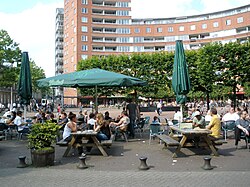
Amsterdam is the capital and most populated city of the Netherlands. It has a population of 1,182,000 in 2024 within the city proper, 1,457,018 in the urban area and 2,480,394 in the metropolitan area. Located in the Dutch province of North Holland, Amsterdam is colloquially referred to as the "Venice of the North", for its large number of canals, now a UNESCO World Heritage Site.

Heineken N.V. is a Dutch multinational brewing company, founded in 1864 by Gerard Adriaan Heineken in Amsterdam. As of 2019, Heineken owns over 165 breweries in more than 70 countries. It produces 348 international, regional, local and speciality beers and ciders and employs approximately 85,000 people.

Koninklijke Grolsch N.V., known simply as Grolsch, is a Dutch brewery founded in 1615 by Willem Neerfeldt in Groenlo. In 1895, the de Groen family bought the brewery. They had started their own brewery in Enschede in the early 19th century and held a significant stake until 2007. Today the main brewery is in Enschede.

Oud-Zuid is the name of a neighbourhood and of a (larger) former borough (stadsdeel) of Amsterdam.
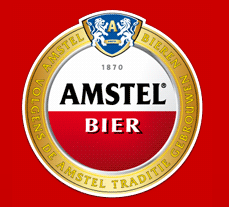
Amstel Brewery is a Dutch brewery founded in 1870 on the Mauritskade in Amsterdam. It was taken over by Heineken International in 1968, and the brewing plant closed down in 1982, with production moving to the main Heineken plant at Zoeterwoude.

The Albert Cuyp Market is a street market in Amsterdam, The Netherlands, on the Albert Cuypstraat between Ferdinand Bolstraat and Van Woustraat, in the De Pijp area of the Oud-Zuid district of the city. The street and market are named for Albert Cuyp, a painter from the 17th century.
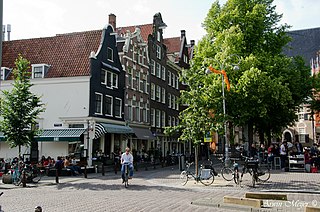
The Noordermarkt is a square in the Jordaan neighborhood of Amsterdam in the Netherlands. The square is dominated by the 17th-Century Noorderkerk church, and is lined by cafés and restaurants. Markets are held on the square every Monday. On Saturdays, a popular organic farmer's market is held on the square. On Mondays a market is also held in the adjacent Westerstraat street.

The Heineken Experience, located in Amsterdam, is a historic brewery and corporate visitor center for the internationally distributed Dutch pilsner, Heineken beer.

The Dutch city of Amsterdam has had many planned expansions over the past two centuries.

The Ferdinand Bolstraat is a street in Amsterdam, named after the artist Ferdinand Bol in 1872.

Amsterdam-Zuid is a borough (stadsdeel) of Amsterdam, Netherlands. The borough was formed in 2010 as a merger of the former boroughs Oud-Zuid and Zuideramstel. The borough has almost 138,000 inhabitants (2013). With 8,500 homes per square kilometer, it is one of the most densely populated boroughs of Amsterdam. It has the highest income per household of all boroughs in Amsterdam.
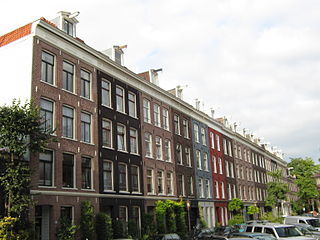
De Pijp is a neighbourhood of Amsterdam, Netherlands. It is located directly south of Amsterdam's city centre and it is part of the borough Amsterdam-Zuid, in a part of the city known as the Old South. It is served by De Pijp metro station. Most streets in De Pijp are named after Dutch painters, like Jan Steen, Frans Hals, Ruysdael and Vincent van Gogh. The three districts composing the area are Oude Pijp, Nieuwe Pijp and Diamantbuurt.

Oude Pijp, also known as Noord-Pijp is a neighbourhood of Amsterdam, Netherlands located in an urbanised part of the Zuid borough. It had a population of 14,102 in 2011 and an area of 68 hectares. Together with Nieuwe Pijp, Oude Pijp forms De Pijp.

Hotel Die Port van Cleve is a historical 4-star hotel on the Nieuwezijds Voorburgwal in Amsterdam. The hotel is situated in the centre of Amsterdam, immediately north of the Magna Plaza shopping centre, and west of the Royal Palace on the Dam Square.
Leonardus (Leo) Petrus Beukeboom was a signpainter and lettering artist from De Pijp, Amsterdam perhaps best known for his krulletters that adorn the city's bruin cafes throughout the central neighborhoods of the Jordaan, de Pijp, and Nieuwe Zijde. Beukeboom was originally trained as a typographic compositor, holding both a diploma and certificate in layout from the Amsterdamse Grafische School. After completing his courses in 1962, Beukeboom worked trivial jobs until 1967 when he began working as a freelance signpainter, almost exclusively for the Amsterdam-based Heineken brewery which commissioned him to decorate cafes as a general advertising strategy, a collaboration that lasted until 1989. Beukeboom devoted over thirty years decorating cafes in the krulletters tradition, until 2001 when forced to retire for health reasons.

The Spuistraat in downtown Amsterdam connects the Hekelveld to the Spui. It runs roughly north to south, parallel to the Singel and the Nieuwezijds Voorburgwal. At the Royal Palace of Amsterdam, the Spuistraat crosses the Raadhuisstraat and Paleisstraat. Originally the Spuistraat was a canal, the Nieuwezijds Achterburgwal. The canal was filled up in 1867, and the street was then renamed.
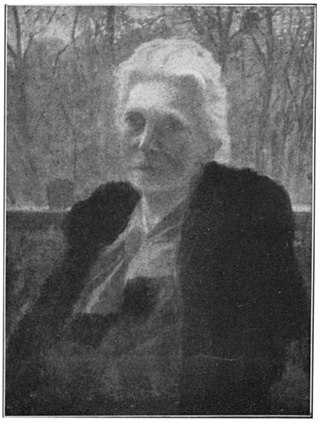
Marie Henriëtte Heineken was a Dutch painter mainly known for flower still lifes. Her paintings are characterised as impressionist.
The following is an alphabetical list of articles related to Amsterdam. Amsterdam is the capital city of the Netherlands.
